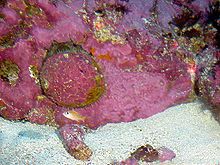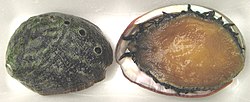Haliotis sorenseni
| Haliotis sorenseni | |
|---|---|

| |
| A live individual ofHaliotis sorenseni,left of center. The shell and the rock are covered with redcoralline algae. | |
| Scientific classification | |
| Domain: | Eukaryota |
| Kingdom: | Animalia |
| Phylum: | Mollusca |
| Class: | Gastropoda |
| Subclass: | Vetigastropoda |
| Order: | Lepetellida |
| Superfamily: | Haliotoidea |
| Family: | Haliotidae |
| Genus: | Haliotis |
| Species: | H. sorenseni
|
| Binomial name | |
| Haliotis sorenseni Bartsch,1940
| |
Thewhite abalone,scientific nameHaliotis sorenseni,is aspeciesof largesea snail,amarinegastropodmolluskin thefamilyHaliotidae,the abalones.[2]
The white abalone is an endangered species in the United States; it may now have the smallest population of all eight of the abalone species on the west coast of North America.
Distribution
[edit]
Historically the white abalone ranged fromPoint Conception,CaliforniatoBaja California,Mexico,and was found especially on the offshore islands.[3]
In the most northerly part of theCaliforniarange, white abalone were reported as being more common along the mainland coast. However, in the middle portion of the California range, they were noted to occur more frequently at the offshore islands, especiallySan ClementeandSanta CatalinaIslands. At the more southerly end of the range, in Baja California, Mexico, white abalone were reported to occur more commonly along the mainland coast, but were also found at a number of islands includingIsla CedrosandIsla Natividad.[3]
It remains unknown whether this distribution pattern was a result of lack of suitable habitat along the mainland coast in the mid portion of the range, or was instead due to overfishing in these more accessible mainland regions.[3]
Since the mid-1990s, extremely low numbers of isolated survivors have been identified along the mainland coast inSanta Barbara Countyand at some of the offshore islands and banks in the middle portion of the range, indicating the current range of white abalone in California may be similar to what it was historically.[3]
No recent information on current range is available for Baja California. The white abalone population in Mexico is thought to be depleted based on commercial fishery data, but the status of the species in Mexico remains largely unknown.[3]
Description
[edit]
Shell
[edit]The white abalone usually has between 3-5 open holes (respiratory pores) in itsshell.These holes collectively make up what is known as theselenizonewhich form as the shell grows. The shell is oval-shaped, very thin and deep. White abalone can grow to about 10 in (25 cm), but are usually 5–8 in (13–20 cm).[3]
Anatomy
[edit]The epipodial tentacles are lacy, beige and yellow-green in color. The bottom of its foot is orange, and the epipodium (a sensory structure and extension of the foot that bears tentacles) is a mottled orange tan.[3]
Ecology
[edit]Habitat
[edit]The white abalone is the deepest dwelling of eight species of California abalones, living at depths from 80 to 200 ft (24–61 m).[3] White abalone are found in open low and high relief rock or boulder habitat that is interspersed with sand channels. Sand channels may be important for the movement and concentration of driftmacroalgae,and a variety of redalgae,upon which white abalone are known to feed.[3]
Feeding habits
[edit]The white abalone is known to be aherbivore,grazing mainly onmacroalgae,such asLaminaria farlowiiandAgarum fimbriatum,and also several species ofred algae.[3]Other species it eats includeChondracanthus exasperatus,Laminaria farlowii,Macrocystis pyrifera,andPalmaria mollis.[4]
Life cycle
[edit]Like many gastropods, white abalone have a complexlife cycleinvolvinglarvalstages.Fertilizedeggs hatch into larvae; these larvae eventuallymetamorphoseinto the adult form and settle from theplanktonto a hardsubstrate.[3] As broadcastspawninggastropods, white abalone reproduce by releasing their eggs andsperminto the surrounding water. If fertilized, the eggs hatch after only one day, but high concentrations of sperm are required in order for an egg to be fertilized. Therefore, aggregations of adult male and female abalone are necessary for successful fertilization to occur.[3]

open squares - commercialcatch per unit effort
left y axis - thousands of pounds of shell per vessel
filled circles - price ofHaliotis sorenseni
right y axis - US$ per pound.
Human use
[edit]Scripps Institution of Oceanographybiologists conducted surveys of white abalone deep water habitat in the early 1970s, finding high concentrations of about one white abalone per square yard. Such densities were comparable to abundance of shallower species of abalone found in previously unfished or protected areas. Unfortunately, the high demand for the species led to a "boom-and-bust" fishery, which decimated the populations of this species in seven years.
Considered adelicacyin California, white abalones, the rarest of the six abalone species in the state, have declined by over 99.99% due to increasingoverfishing,in part illegal – the fishery was closed in 1996 – while at the same time, prices have escalated. Although white abalones were the first marine invertebrate on theUnited States Federal List of Endangered Speciesin 2001, the species could nevertheless become extinct unless extraordinary recovery measures are implemented.[5]White abalone is beingmariculturedin order to produce young that can be placed back in the ocean, in hopes of bringing this species back to secure population levels before it becomes extinct. The White Abalone Restoration Consortium is a partnership with The Cultured Abalone Farm, theSanta Barbara Museum of Natural History Sea Centerand the National Oceanic and Atmospheric Administration Southwest Fisheries Science Center on theGaviota Coastwhich is studying the marine snail and restoring the wild populations. They are also collaborating in developing curriculum to educate the next generation about sustainableaquacultureandconservation.[6]
References
[edit]- Sources
- This article incorporates public domain text (apublic domainwork of the United States Government) from reference[3]and CC-BY-2.5 text from reference[5]
- Team Spawns Rare White Abalone
- White Abalone - An Extinct Possibility?
- Notes
- ^Peters, H., Rogers-Bennett, L. (2021)."Haliotis sorenseni".IUCN Red List of Threatened Species.2021:e.T78771696A78772593.doi:10.2305/IUCN.UK.2021-1.RLTS.T78771696A78772593.en.
{{cite journal}}:CS1 maint: multiple names: authors list (link) - ^Rosenberg, G. (2014). Haliotis sorenseni. Accessed through: World Register of Marine Species athttp://www.marinespecies.org/aphia.php?p=taxdetails&id=445362on 2014-10-29
- ^abcdefghijklm"NOAA Fisheries - White Abalone (Haliotis sorenseni) ".National Oceanic and Atmospheric Administration (USA). 5 May 2017.Retrieved2009-10-21.
- ^McCormick, Thomas B.; Navas, Gabriela; Buckley, Lorraine M.; Biggs, Christopher (December 2016)."Effect of Temperature, Diet, Light, and Cultivation Density on Growth and Survival of Larval and Juvenile White AbaloneHaliotis sorenseni(Bartsch, 1940) ".Journal of Shellfish Research(Submitted manuscript).35(4): 981–992.doi:10.2983/035.035.0421.ISSN0730-8000.OCLC6907956712.
- ^abcdCourchamp F., Angulo E., Rivalan P., Hall R. J., Signoret L., Bull L. & Meinard Y. (2006) "Rarity Value and Species Extinction: The Anthropogenic Allee Effect".PLoS Biology4(12): e415.doi:10.1371/journal.pbio.0040415
- ^Mason, Dave (2021-09-15)."Learning first-hand about conservation".Santa Barbara News-Press.Archived fromthe originalon 2022-01-08.Retrieved2022-01-08.
External links
[edit]- "Race To Save the White Abalone" video links(NOAA Southwest Fisheries Science Center)
- White Abalone Research(NOAA Southwest Fisheries Science Center)
- National Marine Fisheries Service.(October 2008). "White Abalone Recovery Plan (Haliotis sorenseni) ". National Marine Fisheries Service, Long Beach, CA.PDF
- "Hope for the White Abalone" (2004)
- Sonoma County Abalone Network
- "Haliotis (Haliotis) sorenseni".Gastropods.com.Retrieved16 January2019.

